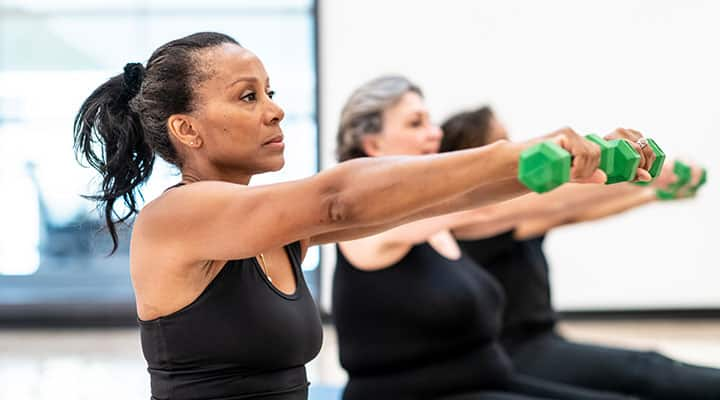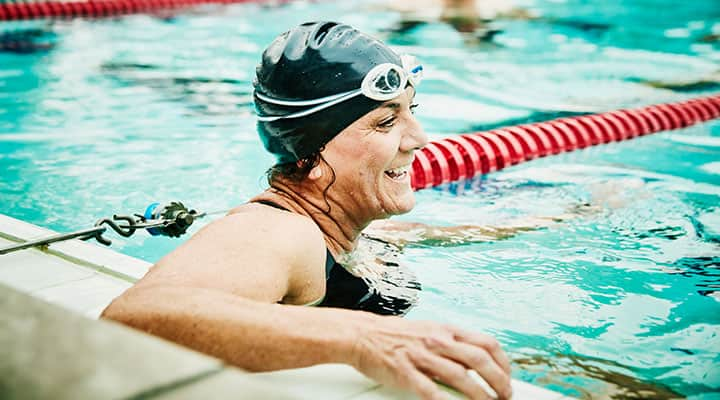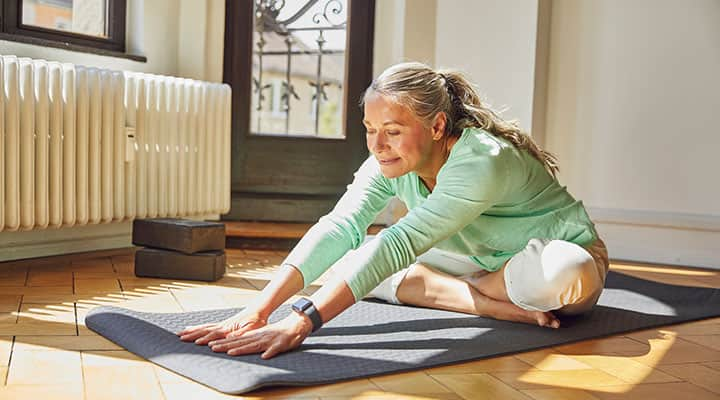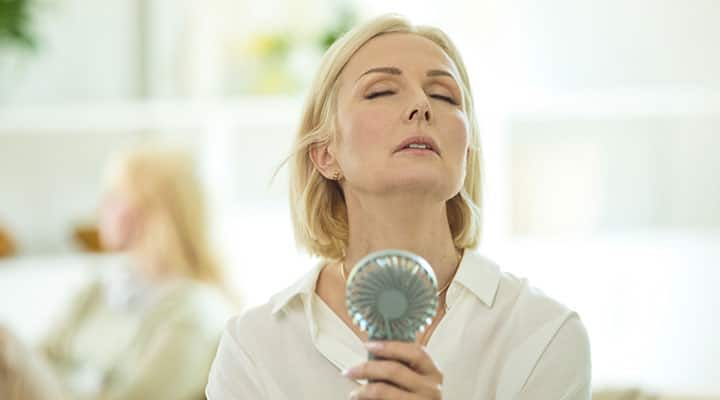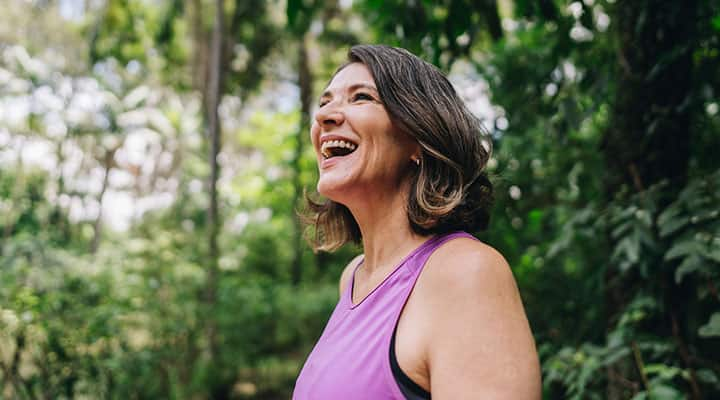
Best Exercises for Menopause
Published: August 2024
Sorry, Cher, but maybe the lyrics should have been: "If I could turn back time…I'd take back my 26-year-old body…and it would stay."
Once you've started feeling the effects of menopause, you'll long for the days when your hair was peak fullness, there wasn't a wrinkle in sight and those skinny jeans fit perfectly around your hips and thighs.
Thanks to estrogen, life was simpler then. But what if we told you that you can be healthier and fitter during "the transition" than you ever were in your booming twenties?
It's true, and your workout routine has a lot to do with it. You'll need to be a little more intentional about how you work out and carefully choose the right types of exercise for menopause. But don't worry, we've got you covered there. Whether you've noticed a few extra pounds on the scale or more inches around your waist, you can turn back the clock with a smarter cardio and strength training plan.
Disclaimer: there's no guarantee you'll look and feel as amazing as Cher, but there's no reason you can't build the body of your dreams with these exercises for menopause.
What are the best exercises for menopause?
Let's get right to it. The best exercises for menopause are, first and foremost, the exercises you will do consistently. Any workout that you enjoy and will stick with for the long run is the best option. An exercise routine should be part of your lifestyle—not a quick fix.
That said, some exercises are proven to be more beneficial during menopause. So, if you want to follow the research, pick one of the following types of exercise to help you manage the effects of menopause. Better yet, combine a few different ones, and you'll get fitter, faster.
Strength training in menopause
Adults start to lose approximately 3-8% of muscle mass per decade, starting at age 30. Muscle loss declines even more rapidly after age 60. To combat these effects, the Centers for Disease Control and Prevention (CDC) recommends adults get at least 150 minutes of moderate-intensity exercise per week, including two separate sessions of strength training.
Strength training is the number one way to build lean muscle. Muscle mass is a precious commodity because it's more metabolically active (aka burns more calories) than fat at rest. Maintaining—and even adding—lean muscle to your frame is a surefire way to fight unwanted weight gain.
To get the most bang for your buff, focus on the major muscle groups of your upper and lower body. These are the best strength exercises to include in your weekly rotation at the gym:
- Squat
- Deadlift
- Lateral lunge
- Hip bridge/thrust
- Chest press or push-up
- Lat pulldown or pull-up
- Low row
- Shoulder press
You can split up the muscle groups, working on upper body exercises one day and lower body on another day. Start with three sets of eight to 15 reps of each exercise. You should reach the point of fatigue after each set. This means that your last rep or two of each set are a struggle, and you cannot get out any more quality reps.
Pro tip: Each week, gradually increase the total number of reps or increase the weight/resistance by about 5-10%. This is called progressive overload, and it forces your muscles to adapt to more tension, thereby leading to muscle gains.
Aerobic activity
When the CDC says "moderate-intensity" physical activity, it's referring to the kind of exercise that gets your heart rate up. It's also called aerobic activity because it requires oxygen and is something you can sustain for a longer period of time. You should feel breathy, but not completely out of breath.
Aerobic activities, like swimming, are especially beneficial for cardiovascular and respiratory health. Several clinical trials involving post-menopausal women (50 to 65 years old) have concluded that 30 minutes of moderate-intensity walking per day combined with two sessions of resistance training per week can support VO2max, as well as healthy blood pressure and cholesterol levels. Not to mention, this type of consistent aerobic activity can promote weight loss and help reduce body fat.
If you've already established a consistent cardio routine, take it to the next level with high-intensity interval training, or HIIT. There is evidence that this type of exercise can help postmenopausal women lose body weight and fat mass, particularly abdominal fat.
Wait, it gets better. You don't have to do your high-intensity interval training on a treadmill at the gym or run sprints around a track. High-intensity cycling workouts are also a great option if you're not a runner.
The most important thing, however, is that you stay consistent with your workouts. Researchers have shown that after just three months of regular high-intensity exercise training, postmenopausal women were able to support healthy insulin sensitivity and skeletal muscle just as much as premenopausal women. If you choose a Tabata-style workout, all you need is four minutes of hard work to reap the benefits.
Yoga benefits for menopausal women
With the age-related loss of muscle, we may also lose balance and stability. The problem is, these are key components of performing activities of daily life. Standing at the sink to wash dishes or carrying a basket of laundry upstairs requires substantial balance and stability. Since menopause has a sneaky way of impacting bone mineral density (BMD), too, women need to be more mindful of maintaining their balance as they age. (You don't want to slip or fall!) Enter: yoga and Pilates.
Yoga requires you to hold postures for extended periods of time, thereby forcing the body to find stability in an unstable environment. Through its core-focused exercises, Pilates is also known for improving balance and stability. More than that, yoga can significantly improve sleep quality and has even been shown to improve other menopausal symptoms, including mood swings.
Pro tip: There are so many different variations of yoga, so you're sure to find a flow that flows with you. If you're completely intimidated by funky, animal-inspired poses, try chair yoga instead. It's a great way to ease into a yoga practice without over-extending yourself—literally.
Pelvic floor exercises
Like certain women's health supplements, pelvic floor exercises are unique essentials for the female body. With age, muscle mass is lost throughout the body—not just in the arms and legs. While it's easy to forget the little guys, the pelvic floor muscles play a big role in bladder health and sexual performance. These may be important concerns as you move into menopause and beyond. So, how do you keep your privates at peak performance?
The most popular type of pelvic floor exercises are Kegel exercises. These require small, frequent muscle contractions that you control while sitting down. In fact, you can do Kegels almost anytime and anywhere and no one will know. The only downside is that it can take some time to find the pelvic floor muscles and learn to properly engage them. Be patient and don't give up on your exercise routine.
Explore Our Best Active Lifestyle & Fitness Supplements
Breathing exercises
If menopause has you feeling high-strung and stressed out, you need to try diaphragmatic breathing. This type of deep breathing allows you to pull in maximum oxygen, while also calming the central nervous system. With each long inhale and long exhale, your body starts to relax, and your worries melt away. The best way to benefit is to perform deep breathing exercises for five to 10 minutes every day. Some popular techniques include alternate nostril breathing, belly breathing, 4-7-8 breathing and mindfulness breathing.
What Is "Menopause Belly"?
Of the many unwelcome effects of menopause, a common one is weight gain. The weight you gain at this time is sneaky and accumulates around the midsection, hence "menopause belly."
Let's be clear, though: "menopause belly" is not a medical term for anything. People use these words to casually describe excessive abdominal weight gain that may occur in tandem with menopause or even perimenopause. And yes, post-menopausal women have been shown to have greater amounts of intra-abdominal fat compared to pre-menopausal women. Unfortunately, there's no strong consensus as to why this type of weight gain happens.
The most likely cause is the shift in hormones. Estrogen is a key component of fat and glucose metabolism. Menopause leads to decreased estrogen levels, which researchers suggest can change your body's ability to metabolize fat. Without adequate estrogen levels, your cells are more likely to take up glucose and free fatty acids and less likely to metabolize these nutrients. In other words, your body is more prone to redistributing fat, leading to changes in body composition, particularly an increase in abdominal fat.
Does that mean you're hopeless in the battle against "menopause belly"? Of course not. Simply focus more attention on strength training to increase lean muscle mass and dial in your nutrition. Remember, muscle mass helps you burn more calories at rest. Choose the right exercises, and you'll become a fat-burning machine!
Will exercises relieve signs of menopause?
One good thing about menopause is you can't miss it. Menopause gives you a lot of warning signs, including changes in weight, bone density, libido and sleep, alongside the more tell-tale signs like mood swings and hot flashes.
If you're experiencing one (or all) of these symptoms, you'll probably do anything to get relief. While exercise isn't a cure-all, it can most certainly boost your health during menopause in a number of ways:
Heart health
– The abdominal weight gain associated with menopause not only affects your waistline but can also impact your heart. Researchers have found that central adiposity, aka belly fat, among postmenopausal women is directly tied to cardiovascular function. By increasing your physical activity, you can mitigate weight gain and protect your heart health.Bone density
– The bad news: bone mineral density (BMD) naturally and inevitably declines after menopause. The good news: any form of exercise can help improve BMD and quality of life in postmenopausal women. HIIT workouts, Tai Chi and progressive overloading (among others) have all been studied and shown to positively influence BMD.Sleep
– Because of hormonal changes and hot flashes, sleep during menopause is often lacking or completely non-existent. While turning to supplements like melatonin is always a quick go-to, exercise is another excellent option.Mood
– The sudden and sharp drop in estrogen can impact your body's ability to produce the "happy hormone" known as serotonin. Add impacted sleep quality and normal life stresses and you have the perfect recipe for mood swings. Luckily, there are several ways to help stop mood swings during menopause, and regular exercise is one of them. Exercise releases feel-good endorphins and has repeatedly been shown to improve overall quality of life.
Exercising at the right intensity can ultimately help relax your muscles and shift your body into rest-and-repair mode. Just be sure to time your exercise appropriately. Exercising too close to bedtime can actually keep you awake.
Want even more support for your health and wellness goals? Take our women's supplement quiz to find the exact formulas that suit your body's needs. The recommendations are based on age and personal health concerns, so you know you're getting the best nutritional recommendations to go alongside the best exercises for menopause.
References
- Adams A. "Progressive Overload Explained: Grow Muscle & Strength Today." NASM. https://blog.nasm.org/progressive-overload-explained
- Anupama DS, et al. "Effect of exercise on bone mineral density and quality of life among postmenopausal women with osteoporosis without fracture: A systematic review." Int J Orthop Trauma Nurs. November 2020. https://pubmed.ncbi.nlm.nih.gov/33041224/
- Asikainen TM, et al. "Exercise for Health for Early Postmenopausal Women." Sports Medicine. September 2012. https://link.springer.com/article/10.2165/00007256-200434110-00004
- Dupuit M, et al. "Effect of high intensity interval training on body composition in women before and after menopause: a meta-analysis." Exp Physiol. September 2020. https://pubmed.ncbi.nlm.nih.gov/32613697/
- Dupuit M, et al. "Moderate-Intensity Continuous Training or High-Intensity Interval Training with or without Resistance Training for Altering Body Composition in Postmenopausal Women." Med Sci Sports Exerc. March 2020. https://pubmed.ncbi.nlm.nih.gov/31524825/
- Greendale G, et al. "Changes in Regional Fat Distribution and Anthropometric Measures Across the Menopause Transition." J Clin Endocrinol Metab. August 2021. https://pubmed.ncbi.nlm.nih.gov/34061966/
- Katzer K, et al. "Lipedema and the Potential Role of Estrogen in Excessive Adipose Tissue Accumulation." Int J Mol Sci. October 2021. https://pubmed.ncbi.nlm.nih.gov/34769153/
- Mandrup CM, et al. "Effects of menopause and high-intensity training on insulin sensitivity and muscle metabolism." Menopause. February 2018. https://pubmed.ncbi.nlm.nih.gov/28953212/
- Marsh M, et al. "Adipocyte Metabolism and Health after Menopause: The Role of Exercise." Nutrients. January 2023. https://www.ncbi.nlm.nih.gov/pmc/articles/PMC9862030/
- Nguyen TM, et al. "Exercise and Quality of Life in Women with Menopausal Symptoms: A Systematic Review and Meta-Analysis of Randomized Controlled Trials." Int J Environ Res Public Health. October 2020. https://www.ncbi.nlm.nih.gov/pmc/articles/PMC7579592/
- Susanti HD, et al. "Effects of yoga on menopausal symptoms and sleep quality across menopause statuses: A randomized controlled trial." Nurs Health Sci. June 2022. https://pubmed.ncbi.nlm.nih.gov/35191141/
- Volpi E, et al. "Muscle tissue changes with aging." Curr Opin Clin Nutr Metab Care. July 2004. https://www.ncbi.nlm.nih.gov/pmc/articles/PMC2804956/
- "Adult Activity: An Overview." CDC. December 2023. https://www.cdc.gov/physical-activity-basics/guidelines/adults.html
Like what you read?
Please subscribe to get email updates on this blog.


